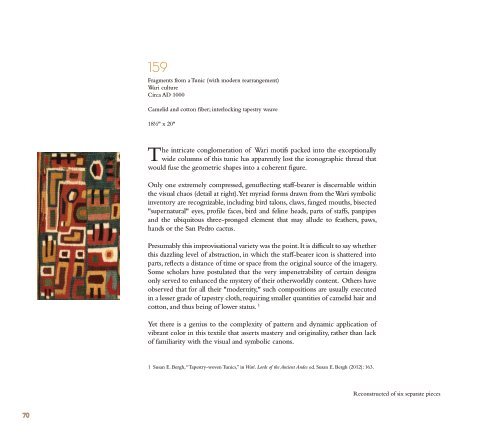You also want an ePaper? Increase the reach of your titles
YUMPU automatically turns print PDFs into web optimized ePapers that Google loves.
159<br />
Fragments from a Tunic (with modern rearrangement)<br />
Wari culture<br />
Circa AD 1000<br />
Camelid and cotton fiber; interlocking tapestry weave<br />
18½" x 20"<br />
The intricate conglomeration of Wari motifs packed into <strong>the</strong> exceptionally<br />
wide columns of this tunic has apparently lost <strong>the</strong> iconographic thread that<br />
would fuse <strong>the</strong> geometric shapes into a coherent figure.<br />
Only one extremely compressed, genuflecting staff-bearer is discernable within<br />
<strong>the</strong> visual chaos (detail at right). Yet myriad forms drawn from <strong>the</strong> Wari symbolic<br />
inventory are recognizable, including bird talons, claws, fanged mouths, bisected<br />
"supernatural" eyes, profile faces, bird and feline heads, parts of staffs, panpipes<br />
and <strong>the</strong> ubiquitous three-pronged element that may allude to fea<strong>the</strong>rs, paws,<br />
hands or <strong>the</strong> San Pedro cactus.<br />
Presumably this improvisational variety was <strong>the</strong> point. It is difficult to say whe<strong>the</strong>r<br />
this dazzling level of abstraction, in which <strong>the</strong> staff-bearer icon is shattered into<br />
parts, reflects a distance of time or space from <strong>the</strong> original source of <strong>the</strong> imagery.<br />
Some scholars have postulated that <strong>the</strong> very impenetrability of certain designs<br />
only served to enhanced <strong>the</strong> mystery of <strong>the</strong>ir o<strong>the</strong>rworldly content. O<strong>the</strong>rs have<br />
observed that for all <strong>the</strong>ir "modernity," such compositions are usually executed<br />
in a lesser grade of tapestry cloth, requiring smaller quantities of camelid hair and<br />
cotton, and thus being of lower status. 1<br />
Yet <strong>the</strong>re is a genius to <strong>the</strong> complexity of pattern and dynamic application of<br />
vibrant color in this textile that asserts mastery and originality, ra<strong>the</strong>r than lack<br />
of familiarity with <strong>the</strong> visual and symbolic canons.<br />
1 Susan E. Bergh, “Tapestry-woven Tunics,” in Wari. Lords of <strong>the</strong> <strong>Ancient</strong> <strong>Andes</strong> ed. Susan E. Bergh (2012): 163.<br />
Reconstructed of six separate pieces<br />
70







